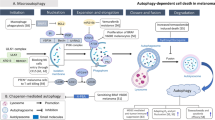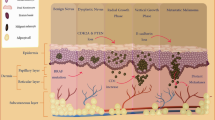Abstract
Melanoma is the most aggressive form of skin cancer, responsible for the majority of skin cancer related deaths. Thus, the search for natural molecules which can effectively destroy tumors while promoting immune activation is essential for designing novel therapies against metastatic melanoma. Here, we report for the first time that a natural triterpenoid, Ganoderic acid DM (GA-DM), induces an orchestrated autophagic and apoptotic cell death, as well as enhanced immunological responses via increased HLA class II presentation in melanoma cells. Annexin V staining and flow cytometry showed that GA-DM treatment induced apoptosis of melanoma cells, which was supported by a detection of increased Bax proteins, co-localization and elevation of Apaf-1 and cytochrome c, and a subsequent cleavage of caspases 9 and 3. Furthermore, GA-DM treatment initiated a possible cross-talk between autophagy and apoptosis as evidenced by increased levels of Beclin-1 and LC3 proteins, and their timely interplay with apoptotic and/or anti-apoptotic molecules in melanoma cells. Despite GA-DM’s moderate cytotoxicity, viable cells expressed high levels of HLA class II proteins with improved antigen presentation and CD4+ T cell recognition. The antitumor efficacy of GA-DM was also investigated in vivo in murine B16 melanoma model, where GA-DM treatment slowed tumor formation with a significant reduction in tumor volume. Taken together, these findings demonstrate the potential of GA-DM as a natural chemo-immunotherapeutic capable of inducing a possible cross-talk between autophagy and apoptosis, as well as improved immune recognition for sustained melanoma tumor clearance.







Similar content being viewed by others
References
Rigel DS, Russak J, Friedman R (2010) The evolution of melanoma diagnosis: 25 years beyond the ABCDs. CA Cancer J Clin 60:301–316
Reed KB, Brewer JD, Lohse CM, Bringe KE, Pruitt CN, Gibson LE (2012) Increasing incidence of melanoma among young adults: an epidemiological study in Olmsted County, Minnesota. Mayo Clin Proc 87:328–334
Blank CU, Hooijkaas AI, Haanen JB, Schumacher TN (2011) Combination of targeted therapy and immunotherapy in melanoma. Cancer Immunol Immunother 60:1359–1371
Boyle GM (2011) Therapy for metastatic melanoma: an overview and update. Expert Rev Anticancer Ther 11:725–737
Balch CM, Gershenwald JE, Soong SJ et al (2009) Final version of 2009 AJCC melanoma staging and classification. J Clin Oncol 27:6199–6206
Bhatia S, Tykodi SS, Thompson JA (2009) Treatment of metastatic melanoma: an overview. Oncology (Williston Park) 23:488–496
Alexandrescu DT, Ichim TE, Riordan NH et al (2010) Immunotherapy for melanoma: current status and perspectives. J Immunother 33:570–590
Boasberg P, Hamid O, O’Day S (2010) Ipilimumab: unleashing the power of the immune system through CTLA-4 blockade. Semin Oncol 37:440–449
Elmore S (2007) Apoptosis: a review of programmed cell death. Toxicol Pathol 35:495–516
He C, Klionsky DJ (2009) Regulation mechanisms and signaling pathways of autophagy. Annu Rev Genet 43:67–93
Gozuacik D, Kimchi A (2004) Autophagy as a cell death and tumor suppressor mechanism. Oncogene 23:2891–2906
Boh B, Berovic M, Zhang J, Zhi-Bin L (2007) Ganoderma lucidum and its pharmaceutically active compounds. Biotechnol Annu Rev 13:265–301
Zhu M, Chang Q, Wong LK, Chong FS, Li RC (1999) Triterpene antioxidants from ganoderma lucidum. Phytother Res 13:529–531
Miyamoto I, Liu J, Shimizu K et al (2009) Regulation of osteoclastogenesis by ganoderic acid DM isolated from Ganoderma lucidum. Eur J Pharmacol 602:1–7
Norton DL, Haque A (2009) Insights into the role of GILT in HLA class II antigen processing and presentation by melanoma. J Oncol 2009:142959
Zhao D, Amria S, Hossain A et al (2011) Enhancement of HLA class II-restricted CD4+ T cell recognition of human melanoma cells following treatment with bryostatin-1. Cell Immunol 271:392–400
Li P, Gregg JL, Wang N et al (2005) Compartmentalization of class II antigen presentation: contribution of cytoplasmic and endosomal processing. Immunol Rev 207:206–217
Nimmerjahn F, Milosevic S, Behrends U et al (2003) Major histocompatibility complex class II-restricted presentation of a cytosolic antigen by autophagy. Eur J Immunol 33:1250–1259
Gannage M, Munz C (2009) Autophagy in MHC class II presentation of endogenous antigens. Curr Top Microbiol Immunol 335:123–140
Strawbridge AB, Blum JS (2007) Autophagy in MHC class II antigen processing. Curr Opin Immunol 19:87–92
Paludan C, Schmid D, Landthaler M et al (2005) Endogenous MHC class II processing of a viral nuclear antigen after autophagy. Science 307:593–596
Dengjel J, Schoor O, Fischer R et al (2005) Autophagy promotes MHC class II presentation of peptides from intracellular source proteins. Proc Natl Acad Sci USA 102:7922–7927
Kumamoto Y, Iwasaki A (2008) MHC class II-presentation of antigen by autophagy. Tanpakushitsu Kakusan Koso 53:2286–2291
Goldstein OG, Hajiaghamohseni LM, Amria S, Sundaram K, Reddy SV, Haque A (2008) Gamma-IFN-inducible-lysosomal thiol reductase modulates acidic proteases and HLA class II antigen processing in melanoma. Cancer Immunol Immunother 57:1461–1470
Haque MA, Hawes JW, Blum JS (2001) Cysteinylation of MHC class II ligands: peptide endocytosis and reduction within APC influences T cell recognition. J Immunol 166:4543–4551
Haque MA, Li P, Jackson SK et al (2002) Absence of gamma-interferon-inducible lysosomal thiol reductase in melanomas disrupts T cell recognition of select immunodominant epitopes. J Exp Med 195:1267–1277
Amria S, Hajiaghamohseni LM, Harbeson C et al (2008) HLA-DM negatively regulates HLA-DR4-restricted collagen pathogenic peptide presentation and T cell recognition. Eur J Immunol 38:1961–1970
Radwan FF, Zhang L, Hossain A, Doonan BP, God JM, Haque A (2011) Mechanisms regulating enhanced human leukocyte antigen class II-mediated CD4+ T cell recognition of human B-cell lymphoma by resveratrol. Leuk Lymphoma 53:305–314
Wu GS, Lu JJ, Guo JJ et al (2012) Ganoderic acid DM, a natural triterpenoid, induces DNA damage, G1 cell cycle arrest and apoptosis in human breast cancer cells. Fitoterapia 83:408–414
Surjit M, Kumar R, Mishra RN, Reddy MK, Chow VT, Lal SK (2005) The severe acute respiratory syndrome coronavirus nucleocapsid protein is phosphorylated and localizes in the cytoplasm by 14-3-3-mediated translocation. J Virol 79:11476–11486
Haque A, Das A, Hajiaghamohseni LM, Younger A, Banik NL, Ray SK (2007) Induction of apoptosis and immune response by all-trans retinoic acid plus interferon-gamma in human malignant glioblastoma T98G and U87MG cells. Cancer Immunol Immunother 56:615–625
Younger AR, Amria S, Jeffrey WA et al (2008) HLA class II antigen presentation by prostate cancer cells. Prostate Cancer Prostatic Dis 11:334–341
Ugen KE, Kutzler MA, Marrero B et al (2006) Regression of subcutaneous B16 melanoma tumors after intratumoral delivery of an IL-15-expressing plasmid followed by in vivo electroporation. Cancer Gene Ther 13:969–974
Srinivasula SM, Ahmad M, Fernandes-Alnemri T, Alnemri ES (1998) Autoactivation of procaspase-9 by Apaf-1-mediated oligomerization. Mol Cell 1:949–957
Raftopoulou M (2005) Mitochondrial wrinkles: the first signs of ageing? Nat Cell Biol 7:853
Mizushima N, Komatsu M (2011) Autophagy: renovation of cells and tissues. Cell 147:728–741
Pattingre S, Tassa A, Qu X et al (2005) Bcl-2 antiapoptotic proteins inhibit Beclin 1-dependent autophagy. Cell 122:927–939
Kadowaki M, Karim MR (2009) Cytosolic LC3 ratio as a quantitative index of macroautophagy. Methods Enzymol 452:199–213
Kerr JF, Winterford CM, Harmon BV (1994) Apoptosis. Its significance in cancer and cancer therapy. Cancer 73:2013–2026
Mujumdar N, Saluja AK (2010) Autophagy in pancreatic cancer: an emerging mechanism of cell death. Autophagy 6:997–998
Hu Y, Benedict MA, Ding L, Nunez G (1999) Role of cytochrome c and dATP/ATP hydrolysis in Apaf-1-mediated caspase-9 activation and apoptosis. EMBO J 18:3586–3595
Reubold TF, Wohlgemuth S, Eschenburg S (2009) A new model for the transition of APAF-1 from inactive monomer to caspase-activating apoptosome. J Biol Chem 284:32717–32724
Ciechomska IA, Goemans GC, Skepper JN, Tolkovsky AM (2009) Bcl-2 complexed with Beclin-1 maintains full anti-apoptotic function. Oncogene 28:2128–2141
Vazquez CL, Colombo MI (2010) Beclin 1 modulates the anti-apoptotic activity of Bcl-2: insights from a pathogen infection system. Autophagy 6:177–178
Slipicevic A, Herlyn M (2012) Narrowing the knowledge gaps for melanoma. Ups J Med Sci 117:237–243
Nikolaou VA, Stratigos AJ, Flaherty KT, Tsao H (2012) Melanoma: new insights and new therapies. J Invest Dermatol 132:854–863
Haque A, Blum JS (2005) New insights in antigen processing and epitope selection: development of novel immunotherapeutic strategies for cancer, autoimmunity and infectious diseases. J Biol Regul Homeost Agents 19:93–104
Acknowledgments
This work was supported by grants from the National Institutes of Health (R01 CA129560 and R01 CA129560-S1 to A. Haque). The research presented in this article was also supported in part by the Tissue Biorepository and Flow Cytometry Shared Resource as part of the Hollings Cancer Center at the Medical University of South Carolina which is funded by a Cancer Center Support Grant P30 CA138313. We thank Drs. Janice Blum (Indiana University, Indianapolis), Craig Slingluff Jr. (University of Virginia, Charlottesville) for melanoma cell lines; Drs. L. Xiang, Christina Johnson, and Carola Neumann (MUSC) for antibodies; Dr. Sakamuri Reddy (Dept. of Pediatrics, MUSC) for his critical reading of the manuscript and Dr. M. Rubinstein (Dept. of Surgery) for technical assistance. We also gratefully acknowledge Dr. Chenthamarakshan Vasu (MUSC) for his Fow Cytometry Facility.
Conflicts of Interest
No conflicts of interest were disclosed by the authors.
Author information
Authors and Affiliations
Corresponding author
Additional information
Azim Hossain and Faisal Radwan contributed equally to this study.
Electronic supplementary material
Below is the link to the electronic supplementary material.
Rights and permissions
About this article
Cite this article
Hossain, A., Radwan, F.F.Y., Doonan, B.P. et al. A possible cross-talk between autophagy and apoptosis in generating an immune response in melanoma. Apoptosis 17, 1066–1078 (2012). https://doi.org/10.1007/s10495-012-0745-y
Published:
Issue Date:
DOI: https://doi.org/10.1007/s10495-012-0745-y




